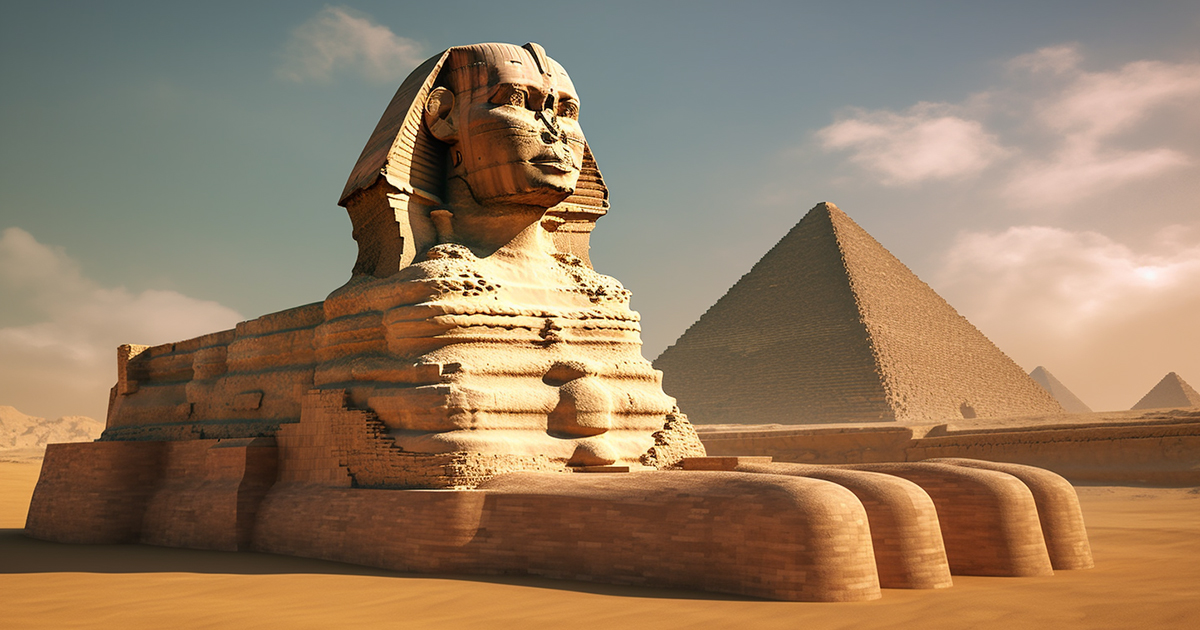Introduction:
In the vast expanse of Egypt, amidst the sands of time, stands an enigmatic guardian that has captivated the imaginations of countless generations. The Great Sphinx of Giza, with its iconic lion’s body and a human head, continues to intrigue archaeologists, historians, and curious minds alike. As one of the world’s most recognizable and enduring symbols of ancient Egypt, the Sphinx has become synonymous with mystery, secrets, and unanswered questions. In this article, we delve into the historical significance, theories, and ongoing research surrounding this timeless marvel.
A Testament to Ancient Mastery:
The Great Sphinx is believed to have been constructed during the reign of Pharaoh Khafre, who ruled Egypt during the Fourth Dynasty of the Old Kingdom, around 2500 BCE. Carved out of a single limestone outcrop, this colossal monument stands 20 meters tall and stretches an impressive 73 meters in length. Its original purpose remains a subject of debate, with various theories emerging throughout history.

Symbolism and Purpose:
One prevailing theory suggests that the Sphinx represented a guardian of divine knowledge and wisdom. The human face, typically believed to resemble Khafre, may symbolize the pharaoh’s divine connection and his role as a mediator between the earthly and celestial realms. The lion’s body, on the other hand, symbolizes strength, power, and protection. The positioning of the Sphinx, facing directly eastward, is often associated with the rising sun and the cycle of rebirth—a symbol of eternal life in ancient Egyptian beliefs.
Mysteries and Unanswered Questions:
Despite the extensive research conducted on the Sphinx over the centuries, numerous mysteries continue to shroud this ancient wonder. One perplexing aspect is the erosion patterns found on its body, particularly the deep weathering seen on its flanks. These patterns have led some scholars, most notably geologist Dr. Robert Schoch, to propose that the Sphinx might be much older than previously thought, dating back to a time when Egypt experienced a more significant amount of rainfall. This theory challenges the mainstream belief that the Sphinx was built during the Old Kingdom.
Furthermore, the absence of any inscriptions or textual evidence directly linking the Sphinx to its creators has sparked further intrigue. While many other ancient Egyptian structures bear inscriptions or hieroglyphs providing insight into their purpose or the individuals responsible for their construction, the Sphinx remains an enigmatic anomaly.
Modern Scientific Exploration:
In recent years, advanced technologies have enabled researchers to gain new perspectives on the mysteries surrounding the Sphinx. Ground-penetrating radar surveys and other non-invasive techniques have been employed to investigate the possibility of hidden chambers or passages beneath the monument. The most notable of these studies was conducted in 1991 by a team led by Dr. Mark Lehner, which revealed intriguing anomalies beneath the Sphinx’s paws. However, further exploration is needed to unravel the secrets hidden beneath the sands.
Preservation and Conservation Efforts:
Protecting the Great Sphinx and ensuring its preservation for future generations is of utmost importance. Over time, environmental factors such as humidity, pollution, and rising groundwater levels have taken a toll on the monument. Recognizing its significance, various restoration and conservation efforts have been undertaken to safeguard this iconic symbol of ancient Egypt’s grandeur.
Conclusion:
The Great Sphinx of Giza continues to mesmerize us with its awe-inspiring presence and enigmatic allure. As we explore its ancient origins and contemplate its purpose, we are reminded of the boundless ingenuity and craftsmanship of our ancestors. The ongoing research, combined with technological advancements, promises to shed new light on the mysteries that surround this timeless guardian. As the sands of time shift and the world evolves, the Sphinx remains an enduring testament to human curiosity, perseverance, and the eternal quest for knowledge.

2 thoughts on “The Enigmatic Sphinx of Egypt: Unraveling the Mysteries of a Timeless Guardian”
Comments are closed.